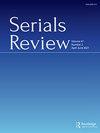Predatory Publishing in Indian LIS Research: A Case Study
IF 0.9
4区 管理学
Q3 INFORMATION SCIENCE & LIBRARY SCIENCE
引用次数: 0
Abstract
Abstract The study examines the possible predatory journals in Library and Information Science research in India, including the affiliation status of the authors publishing in those predatory journals, frequency of returning authors, and country-wise distribution of authors. The paper used Beall’s list to find out the predatory journals in LIS published from India. Publication trends, affiliations of authors, and the status of the 22 LIS journals under the study were critically analyzed. The result shows that the predatory journals were diminishing slowly; in 2016, there were eight active journals, while in 2021, it was reduced to four journals. Similarly, the publication trends show that the highest number of articles (398) was published in the year 2015, and it was only 66 articles in 2020. It is revealed that academics hailing from state universities (42.88%) are the highest contributors to the predatory journals, followed by professionals from government colleges (16.76%). The results indicate that predatory publishing was rampant in the early years but declined gradually. Researchers from India have published the most articles, totaling 1760 (93%), followed by those from Nigeria (64, 3.3%), Bangladesh (10), and Saudi Arabia (eight articles). It is also revealed that 21.66% (n = 438) are returning authors who have published more than one article in the sample journals. The paper discusses the role of the government and especially the University Grants Commission (UGC) in curbing the menace of predatory publishing. The authors also discuss the possible role of library professionals in stopping the plague of predatory publishing.印度法律研究中的掠夺性出版:一个案例研究
摘要本研究考察了印度图书馆情报学研究中可能存在的掠夺性期刊,包括作者在这些掠夺性期刊上发表的隶属关系、作者回国的频率以及作者的国家分布。这篇论文利用Beall的名单找出了印度在美国出版的掠夺性期刊。对22种美国期刊的出版趋势、作者隶属关系和现状进行了批判性分析。结果表明:掠夺性期刊数量在缓慢减少;2016年有8种活跃期刊,而2021年减少到4种。同样,发表趋势显示,2015年发表了最多的文章(398篇),到2020年只有66篇。来自公立大学的学者(42.88%)是这些掠夺性期刊的最大贡献者,其次是来自公立大学的专业人士(16.76%)。结果表明,掠夺性出版在早期十分猖獗,但后来逐渐减少。来自印度的研究人员发表的文章最多,共计1760篇(93%),其次是尼日利亚(64篇,3.3%)、孟加拉国(10篇)和沙特阿拉伯(8篇)。21.66% (n = 438)的归国作者在样本期刊上发表了一篇以上的文章。本文探讨政府,特别是大学教育资助委员会(教资会)在遏止掠夺性出版威胁方面的角色。作者还讨论了图书馆专业人员在阻止掠夺性出版瘟疫中可能发挥的作用。
本文章由计算机程序翻译,如有差异,请以英文原文为准。
求助全文
约1分钟内获得全文
求助全文
来源期刊

Serials Review
INFORMATION SCIENCE & LIBRARY SCIENCE-
CiteScore
1.60
自引率
11.10%
发文量
49
期刊介绍:
Serials Review, issued quarterly, is a peer-reviewed scholarly journal for the international serials community. Articles focus on serials in the broadest sense of the term and cover all aspects of serials information; regular columns feature interviews, exchanges on controversial topics, book reviews, and conference reports. The journal encompasses practical, theoretical, and visionary ideas for librarians, publishers, vendors, and anyone interested in the changing nature of serials. Serials Review covers all aspects of serials management: format considerations, publishing models, statistical studies, collection analysis, collaborative efforts, reference and access issues, cataloging and acquisitions, people who have shaped the serials community, and topical bibliographic studies.
 求助内容:
求助内容: 应助结果提醒方式:
应助结果提醒方式:


